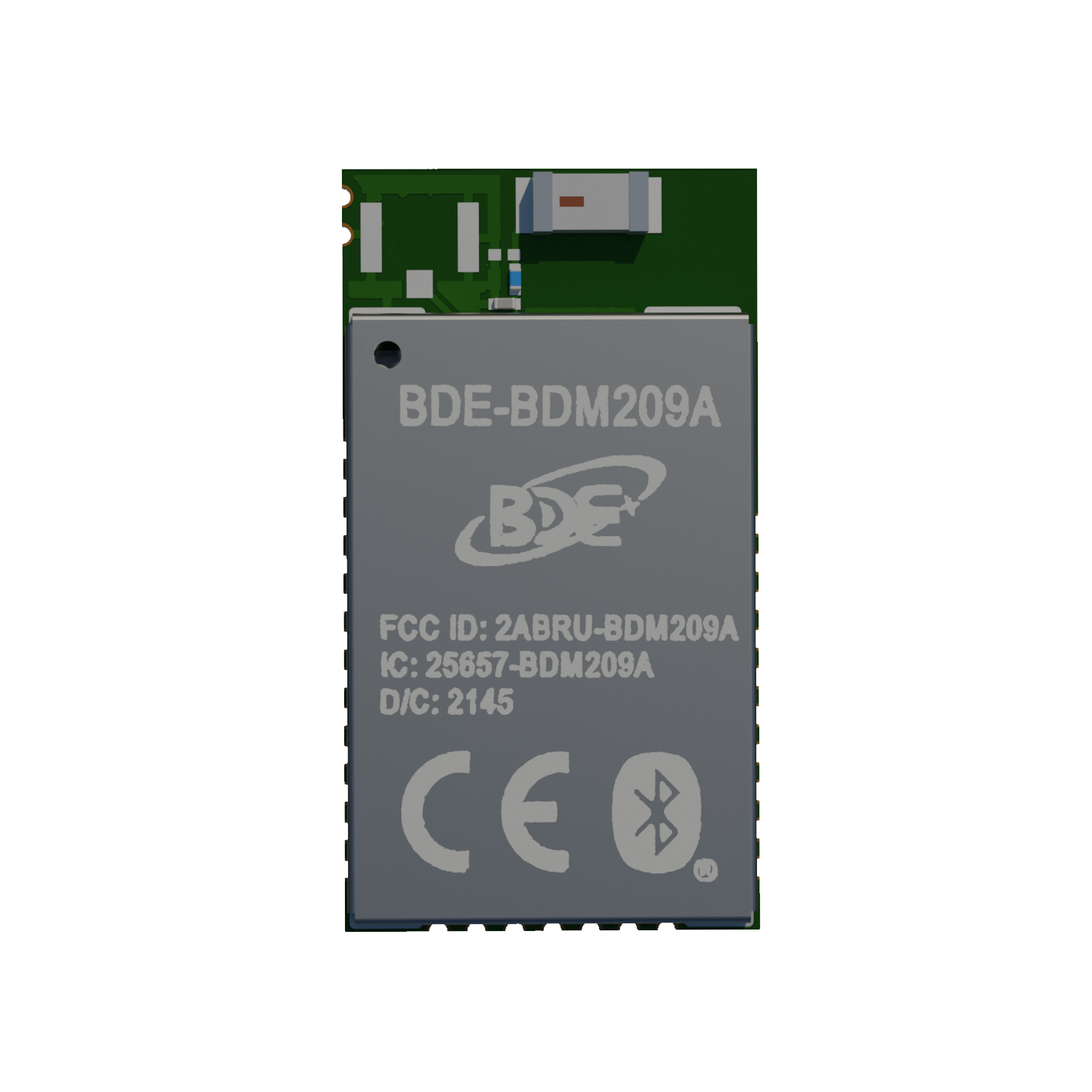您现在的位置:首页 - 产品中心
产品中心
双模蓝牙 - BDE-BDM209A
- BDE-BDM209A
- 浏览 4289 次 发布日期:[ 2021-5-19 ]

碧德(BDE)是美国德州仪器(TI)第三方合作伙伴
BDE-BDM209A
BDE-BDM209A是蓝牙5.1 BR/EDR和BLE双模式模块。该模块提供了一个独特的蓝牙经典和蓝牙低能耗无线电TI的CC2564C和一个ARM 32位Cortex-M4F CPU MSP432,集成了包括天线在内的所有外部组件,成本非常低廉。该模块提供了同类中最好的射频性能,发射功率和接收灵敏度提供了两倍的范围和更高的吞吐量,比其他低功耗蓝牙解决方案。在所有常用的蓝牙BR/EDR和低能耗运行模式中,电源管理硬件和软件算法提供了显著的功耗节省。认证和免版税的双模式蓝牙4.2协议栈软件提供了完整的蓝牙BR/EDR和蓝牙低能耗样品应用程序,减少了设计工作,并确保更快的上市时间。
Key Features-Processing and memories- Arm® 32-bit Cortex®-M4F CPU with floating point unit and memory protection unit- Frequency up to 48 MHz- 256KB flash main memory (organized into two banks enabling simultaneous read or execute during erase)- 16KB of flash information memory- 64KB of SRAM (including 6KB of backup memory)- 32KB of ROM with MSP432™ peripheral driver libraries- Bluetooth 5.1 Declaration ID D049226- BR and EDR Features Include:- Up to Seven Active Devices- Scatternet: Up to Three Piconets Simultaneously, One as Master and Two as Slaves- Up to Two Synchronous Connection Oriented (SCO) Links on the Same Piconet- Support for All Voice Air-Coding—Continuously Variable Slope Delta (CVSD), A-Law, μ-Law, and Transparent (Uncoded)- Assisted Mode for HFP 1.6 Wideband Speech (WBS) Profile or A2DP Profile to Reduce Host Processing and Power- Support of Multiple Bluetooth Profiles with Enhanced QoS- Bluetooth Low Energy Features Include:- Support of up to 10 Simultaneous Connections- Multiple Sniff Instances Tightly Coupled to Achieve Minimum Power Consumption- Independent Buffering for Low Energy Allows Large Numbers of Multiple Connections Without Affecting BR or EDR Performance- Built-In Coexistence and Prioritization Handling for BR, EDR, and Low Energy- Best-in-Class Bluetooth (RF) Performance (TX Power, RX Sensitivity, Blocking)- Class 1.5 TX Power up to +10 dBm- –93 dBm Typical RX Sensitivity- Internal Temperature Detection and Compensation to Ensure Minimal Variation in RF Performance Over Temperature, No External Calibration Required- Improved Adaptive Frequency Hopping (AFH) Algorithm with Minimum Adaptation Time- Provides Longer Range, Including Twice the Range of Other Low-Energy-Only Solutions- Advanced Power Management for Extended Battery Life and Ease of Design- Low Power Consumption for Active, Standby, and Scan Bluetooth Modes- Shutdown and Sleep Modes to Minimize Power Consumption- MCU Ultra-low-power operating modes when Bluetooth is Shutdown- Active: 80 μA/MHz- Low-frequency active: 83 μA at 128 kHz- LPM3 (with RTC): 660 nA- LPM3.5 (with RTC): 630 nA- LPM4: 500 nA- LPM4.5: 25 nA- Operating characteristics- Wide supply voltage range: 2.05V to 3.7V- Temperature range: –40°C to 85°C- Flexible clocking features- Tunable internal DCO (up to 48 MHz)- 32.768-kHz low-frequency crystal support (LFXT)- High-frequency crystal support (HFXT) up to 48 MHz- Low-frequency internal reference oscillator (REFO)- Very low-power low-frequency internal oscillator (VLO)- Module oscillator (MODOSC)- System oscillator (SYSOSC)- Code security features- JTAG and SWD lock- IP protection (up to four secure flash zones, each with configurable start address and size)- Enhanced system features- Programmable supervision and monitoring of supply voltage- Multiple-class resets for better control of application and debug- RTC with calendar and alarm functions- Timing and control- Up to four 16-bit timers, each with up to five capture, compare, PWM capability- Two 32-bit timers, each with interrupt generation capability- Physical Interfaces:- UART with automatic baud-rate detection- I2C (with multiple-slave addressing)- SPI (up to 16 Mbps)- Up to 17 GPIOs for users- All GPIOs with capacitive-touch capability- Ultra-low-leakage I/Os (±20 nA maximum)- Up to 15 I/Os with interrupt and wake-up capability- Two I/Os with glitch filtering capability- Fully Programmable Digital Pulse-Code Modulation (PCM)–I2S Codec Interface- Antenna: Chip antenna or U.FL connector- Encryption and data integrity accelerators- 128-, 192-, or 256-bit AES encryption and decryption accelerator- 32-bit hardware CRC engine- Bluetooth 4.2 Dual-mode stack- dual-mode Bluetooth 4.2 certified and royalty free- Fully qualified Bluetooth stack (QDID 85355 and QDID 69886)- Classic Bluetooth Profiles Available- A2DP1.2, AVDTP1.2, AVRCP1.3, HSP1.2, GAP, HID1.0, MAP1.0, PBAP1.0, RFCOMM, SDP, SPP.- Bluetooth low energy Profiles Available- ANS1.0, BAS1.0, CSCS1.0, DIS1.0, FMP1.0, GAPS1.0, GATT1.0, HTS1.0, HRS1.0, HIDS1.0, IAS1.0, LLS1.0, PASS1.0, PXP1.0, TPS1.0.- MFi Support- iAP Protocol (iAP 1/iAP 2) provided as an add-on upon request- Packaging- 12 mm x 22 mm x 2.1 mm package- Large variety of Sample Applications- Classic Bluetooth Sample Applications include: A3DP Sink/Source, HFP, HID, HSP, MAP, PBAP, SPP application demos.- BLE Sample Applications include: ANP, iBeacon, HRP, HTP, PASP, HOGP, PXP, FMP, CSCP application demos.- Classic Bluetooth + Bluetooth low energy Sample Applications include: SPP+SPPLE, SPP DMMulti application demos.- Development Environment supports:- CCS, Keil®, and IAR Embedded Workbench® IDEs.- Standards Conformance- Bluetooth- DID: D054396, QDID: 165249- FCC ID: 2ABRUBDM209A- IC: 25657-BDM209A- CE-RED- Japan- Korea- Taiwan- Australia- New Zealand- China应用:- 医疗设备- 运动和健身器材- 家用电子产品- 手机和电脑配件- 工业自动化下载:下- 下一个:BDE-BD2564CA
Copyright © 2018-2022 广州碧德科技股份有限公司 版权所有


